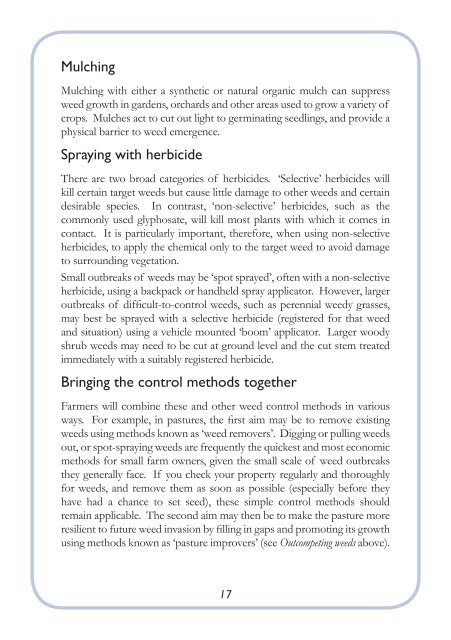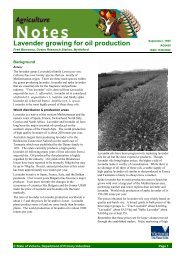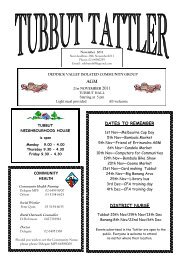Weed Detection and Control on Small Farms - University of New ...
Weed Detection and Control on Small Farms - University of New ...
Weed Detection and Control on Small Farms - University of New ...
Create successful ePaper yourself
Turn your PDF publications into a flip-book with our unique Google optimized e-Paper software.
Mulching<br />
Mulching with either a synthetic or natural organic mulch can suppress<br />
weed growth in gardens, orchards <str<strong>on</strong>g>and</str<strong>on</strong>g> other areas used to grow a variety <strong>of</strong><br />
crops. Mulches act to cut out light to germinating seedlings, <str<strong>on</strong>g>and</str<strong>on</strong>g> provide a<br />
physical barrier to weed emergence.<br />
Spraying with herbicide<br />
There are two broad categories <strong>of</strong> herbicides. ‘Selective’ herbicides will<br />
kill certain target weeds but cause little damage to other weeds <str<strong>on</strong>g>and</str<strong>on</strong>g> certain<br />
desirable species. In c<strong>on</strong>trast, ‘n<strong>on</strong>-selective’ herbicides, such as the<br />
comm<strong>on</strong>ly used glyphosate, will kill most plants with which it comes in<br />
c<strong>on</strong>tact. It is particularly important, therefore, when using n<strong>on</strong>-selective<br />
herbicides, to apply the chemical <strong>on</strong>ly to the target weed to avoid damage<br />
to surrounding vegetati<strong>on</strong>.<br />
<strong>Small</strong> outbreaks <strong>of</strong> weeds may be ‘spot sprayed’, <strong>of</strong>ten with a n<strong>on</strong>-selective<br />
herbicide, using a backpack or h<str<strong>on</strong>g>and</str<strong>on</strong>g>held spray applicator. However, larger<br />
outbreaks <strong>of</strong> difficult-to-c<strong>on</strong>trol weeds, such as perennial weedy grasses,<br />
may best be sprayed with a selective herbicide (registered for that weed<br />
<str<strong>on</strong>g>and</str<strong>on</strong>g> situati<strong>on</strong>) using a vehicle mounted ‘boom’ applicator. Larger woody<br />
shrub weeds may need to be cut at ground level <str<strong>on</strong>g>and</str<strong>on</strong>g> the cut stem treated<br />
immediately with a suitably registered herbicide.<br />
Bringing the c<strong>on</strong>trol methods together<br />
Farmers will combine these <str<strong>on</strong>g>and</str<strong>on</strong>g> other weed c<strong>on</strong>trol methods in various<br />
ways. For example, in pastures, the first aim may be to remove existing<br />
weeds using methods known as ‘weed removers’. Digging or pulling weeds<br />
out, or spot-spraying weeds are frequently the quickest <str<strong>on</strong>g>and</str<strong>on</strong>g> most ec<strong>on</strong>omic<br />
methods for small farm owners, given the small scale <strong>of</strong> weed outbreaks<br />
they generally face. If you check your property regularly <str<strong>on</strong>g>and</str<strong>on</strong>g> thoroughly<br />
for weeds, <str<strong>on</strong>g>and</str<strong>on</strong>g> remove them as so<strong>on</strong> as possible (especially before they<br />
have had a chance to set seed), these simple c<strong>on</strong>trol methods should<br />
remain applicable. The sec<strong>on</strong>d aim may then be to make the pasture more<br />
resilient to future weed invasi<strong>on</strong> by filling in gaps <str<strong>on</strong>g>and</str<strong>on</strong>g> promoting its growth<br />
using methods known as ‘pasture improvers’ (see Outcompeting weeds above).<br />
17
















